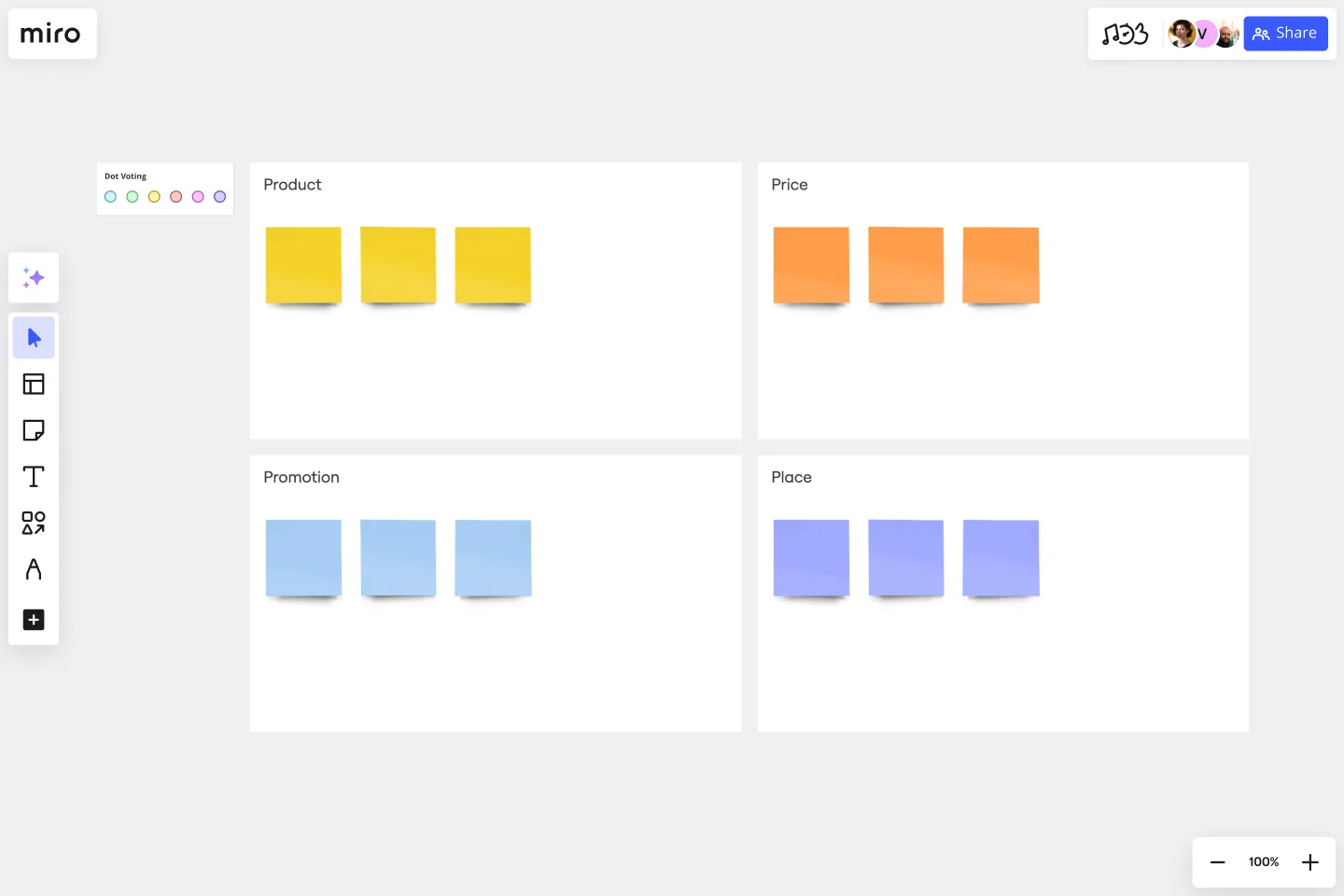4P Marketing Mix Template
Map a marketing mix that meets the needs of your target audience.
About the 4P Marketing Mix template
What is a 4P marketing mix?
A marketing mix comprises the elements an organization might use to execute a successful marketing plan. The term was coined in the late 1940s, and Harvard professor Neil Borden used it in his 1953 address to the American Marketing Association.
The 4P Marketing Mix Template allows you to map out four controllable factors affecting your company profits: product, place, promotion, and price. By deciding on the mix of these four factors, you can determine the ideal way to take a new product or service to market. Read on to find out more about how this template can help your team
What are the 4 Ps?
The 4 Ps stand for: Product, Place, Promotions, and Price. Let’s look at each one in more detail.
Product: is the tangible good or service that satisfies the target audience’s needs.
Place: refers to where and when the product is available.
Promotions: include advertising, digital marketing, PR, event marketing, direct marketing, personal selling, channel marketing, and alliances.
Price: consists of the policies regarding basic price, upgrades, discounts, coupons, distributor price, etc.
Benefits of marketing mixes
An effective marketing mix can help your business develop strengths and limit weaknesses, become more competitive, adapt to the market, and collaborate with partners. Specifically, a marketing mix can help your organization answer the following questions: Who is your customer? What problem do they have? What prevents them from solving it? How does your product or service solve that problem? How does your customer or potential customer feel about your competitors? How do they feel about your business? What motivates them to make a purchasing decision?
When to use a 4P marketing mix
Organizations can develop a marketing mix at any stage of growth. Once you’ve answered the questions above, you can begin to build your marketing strategy.
Create your own 4P marketing mix
Miro is the perfect tool to create and share your marketing mix. Here’s how to create yours using this template:
Step 1: Start by selecting this 4P Marketing Mix template.
Step 2: Choose a specific product or service to analyze.
Step 3: Go through each quadrant, adding relevant information in sticky notes or uploading other file types.
You may also want to color code your sticky notes so you can distinguish between positive and negative points. Once your team is satisfied with the result, you can easily share with other teams to get their feedback.
Discover more marketing plan template examples and supercharge your marketing efforts.
Get started with this template right now.
Agile Product Roadmap (Now, Next, Later)
Works best for:
Product Roadmap
Stay ahead in your product development with the Agile Product Roadmap Now Next Later template. This tool allows you to plan and prioritize features and improvements dynamically, ensuring your product evolves with market needs. Visualize short-term, mid-term, and long-term goals to keep your team focused and aligned. Perfect for product managers and agile teams aiming to deliver continuous value.
User Persona Template
Works best for:
Marketing, Desk Research, User Experience
A user persona is a tool for representing and summarizing a target audience for your product or service that you have researched or observed. Whether you’re in content marketing, product marketing, design, or sales, you operate with a target in mind. Maybe it’s your customer or prospect. Maybe it’s someone who will benefit from your product or service. Usually, it’s a whole collection of personalities and needs that intersect in interesting ways. By distilling your knowledge about a user, you create a model for the person you hope to target: this is a persona.
Annual Calendar Template
Works best for:
Business Management, Strategic Planning, Project Planning
Plenty of calendars help you focus on the day-to-day deadlines. With this one, it’s all about the big picture. Borrowing from the grid structure of 12-month wall calendars, this template shows you your projects, commitments, and goals one full year at a time. So you and your team can prepare to hunker down during busy periods, move things around as needed, and celebrate your progress. And getting started is so easy—just name your calendar’s color-coded streams and drag stickies onto the start date.
Working Backwards Template
Works best for:
Desk Research, Strategic Planning, Product Management
Find out how to use the Working Backwards template to plan, structure, and execute the launch of a new product. Using the template, you’ll figure out if the product is worth launching in the first place.
Agile Board Template
Works best for:
Agile Methodology, Meetings, Agile Workflows
Part of the popular Agile framework, an Agile Board is a visual display that allows you to sync on tasks throughout a production cycle. The Agile Board is typically used in the context of Agile development methods like Kanban and Scrum, but anyone can adopt the tool. Used by software developers and project managers, the Agile Board helps manage workload in a flexible, transparent and iterative way. The Agile template provides an easy way to get started with a premade layout of sticky notes customizable for your tasks and team.
SAFe Roam Board
Works best for:
Agile Methodology, Operations, Agile Workflows
A SAFe ROAM Board is a framework for making risks visible. It gives you and your team a shared space to notice and highlight risks, so they don’t get ignored. The ROAM Board helps everyone consider the likelihood and impact of risks, and decide which risks are low priority versus high priority. The underlying principles of SAFe (Scaled Agile Framework) are: drive cost-effective solutions, apply systems thinking, assume that things will change, build incrementally, base milestones on evaluating working systems, and visualize and limit works in progress.
